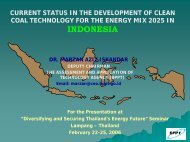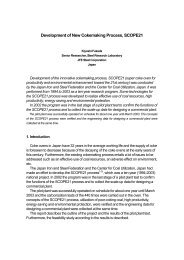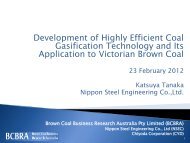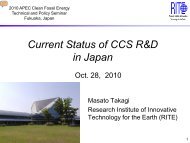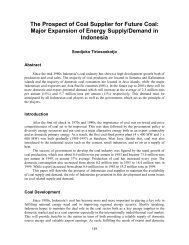Defining CCS Ready: An Approach to An International Definition
Defining CCS Ready: An Approach to An International Definition
Defining CCS Ready: An Approach to An International Definition
- No tags were found...
You also want an ePaper? Increase the reach of your titles
YUMPU automatically turns print PDFs into web optimized ePapers that Google loves.
Chapter 4: S<strong>to</strong>rage <strong>Ready</strong> Plant <strong>Definition</strong>• CO 2 s<strong>to</strong>rage with enhanced oil or gas recovery offers potential where suitable oiland gas fields are present, and has significant potential in areas with large oil reserves.The technology is commercially available for onshore regions, and is expected <strong>to</strong> beapplicable <strong>to</strong> <strong>CCS</strong>. The economic benefits of enhanced oil production can partially offset<strong>CCS</strong> costs. The applicability of this option offshore has been limited by economicconsiderations and an available supply of CO 2 . S<strong>to</strong>rage with Enhanced Gas Recovery iscurrently unproven, and is at the demonstration stage.• Depleted oil and gas fields provide further options for s<strong>to</strong>rage once oil and gasproduction have ended. Like enhanced oil recovery, this option is of interest primarily inmajor oil- and gas-bearing regions, including offshore areas (e.g., the North Sea). Thefield availability is a key issue depending on economics of hydrocarbon depletion. Thereuse of facilities and wells could be economic benefits of this option, subject <strong>to</strong> sitespecificissues and consideration of the viability of reusing facilities and wells, along withwell integrity risks.• Saline reservoir formations are considered the most important of the option typesfor large-scale long-term s<strong>to</strong>rage. Their importance is due <strong>to</strong> their widespreadavailability, including areas without oil and gas, <strong>to</strong>gether with large capacity. However,initial geological understanding is more limited for this option than for oil and gasreservoirs, and less data are available. In view of less evidence for effective trapping,detailed assessment will be required. Consequently, new exploration and appraisalactivities incorporating seismic acquisition and drilling will generally be required, and maytake several years. In specific areas, there is a risk that sites will not be confirmed andvalidated by the detailed investigations.Other theoretical types of s<strong>to</strong>rage are:• S<strong>to</strong>rage in coals, and in coals associated with enhanced coalbed methane production.This option may also be available for shale gas resources.• S<strong>to</strong>rage in basalts, salt caverns, disused mines, and carbonation of ultramafic rocks.These options are currently considered lower priority, because the underlying technicalviability has yet <strong>to</strong> be confirmed, further research and pilot testing are required, or they arelimited by inadequate capacity or injectivity. In addition, geological s<strong>to</strong>rage types arecategorized by onshore versus offshore. While many countries are considering bothonshore and offshore s<strong>to</strong>rage, the UK, for example, has limited the potential s<strong>to</strong>rage sites <strong>to</strong>offshore regions only. 91As noted in the proposed S<strong>to</strong>rage <strong>Ready</strong> plant definition, the full volume of captured CO 2from the eventual capture plant will need <strong>to</strong> be s<strong>to</strong>red in one or more selected s<strong>to</strong>ragesites. Therefore, knowledge about the amount of CO 2 expected <strong>to</strong> be s<strong>to</strong>red in a potentials<strong>to</strong>rage site would help in determining whether the selected site(s) has the required s<strong>to</strong>ragecapacity. For example, the UK Guidance note addresses this issue: “Applicants shouldinclude information on the amount of CO 2 that would be produced and s<strong>to</strong>red as part of91 Paragraph 33, page 15 of U.K. Department of Energy and Climate Change (U.K. DECC). (2009a). Carbon capturereadiness (CCR): A guidance note for Section 36 Electricity Act 1989 consent applications (Publication no. URN 09D/810).London, UK: Author.23 February 2010 49



